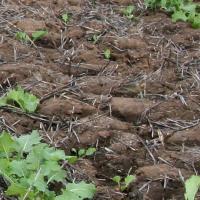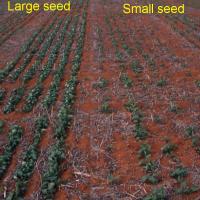Diagnosing poor quality seed in canola
Poor grain quality seed can impact on germination rates and market quality. It can be due to small seed or damage by harvest, storage, weather or environment.
What to look for
- Reduced germination and/or weak seedlings that may uniformly affected across a paddock, or more pronounced in rows or areas that are less favourable for germination and early growth.
Paddock
- Seeds swell but fail to germinate.
- Seed germinates but seedlings are malformed or too weak to to reach the surface.
- Weak seedlings after emergence.
- Broadleaf seedlings with broken roots, cotyledons or growing points.
Plant
What else could it be
| Condition | Similarities | Differences |
|---|---|---|
| Deep seeding in canola | Reduced emergence and weak seedlings | Confirm by measuring seeding depth |
Where did it come from?
- Small seed (less than 1.8 mg) is less resilient than large seed.
- Poor storage where seed is exposed to moist and hot conditions.
- Old seed. Canola seed quality declines faster than for cereals.
- Frost-affected grain
- Green sappy grain that has been harvested too early.
- Insect damaged grain.
Management strategies
- Germination test seed
- Do not use seed weighing less than 1.8 mg
How can it be monitored?
- Germination test grain being retained for seed
Where to go for expert help
Page last updated: Tuesday, 10 June 2014 - 2:24pm





